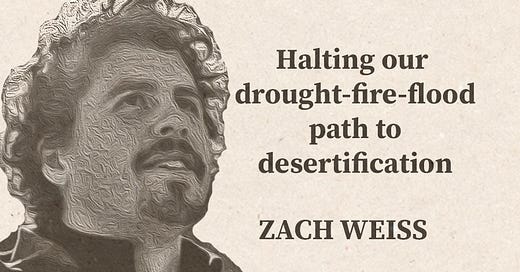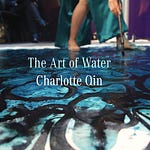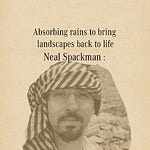Awhile back I was pondering what to do about the California wildfires, when I came across a Zach Weiss video showing how we could hydrate the environment and bring back the small water cycle. This video, along with Charles Eisenstein’s water chapter in his book “Climate”, got me into the water field. I am very happy to present here an interview with Zach.
………….
Zach Weiss is a sculptor and tender of the land. He reads the landscape like a tracker, understanding how water moves across it; looking at movement of the soils, the cuts in the land and the erosion; noticing where water has pooled and evaporated and the patterns of vegetation growth.
He studies the landscape to figure out where to make the interventions. The healthier it is the more it is about tending. The more degraded it is, whether from over-farming, from certain types of development, or from mining, the more it is about sculpting. He studies where to place the terraces that will slow the rain and help it infiltrate downwards. Where to dig the drainage ponds that collect the wet season’s water from the sky and slowly filter it downwards, filling the aquifers and providing drinking water and agricultural water. Where to dig the year round ponds so they can birth an ecosystem. What to grow around the edges of the pond to interact with the wildlife, to filter any inflowing pollution. He studies to understand the interconnectedness of the layers of soil, vegetation, rivers, springs, aquifers, wildlife, and human-made grey infrastructure.
He worked a piece of land in Australia for a worm farmer, two weeks of work sculpting the land so it caught the rains when they came in the wet season. Then the worst drought on record hit the region. Vegetation dried up in the farms around him. Farmers in the region went belly up, and many had to sell their cows. But the worm farmer’s land was different. The soil stayed hydrated and cool enough from the previous season’s rains, keeping the lands cool and allowing the worms to flourish.
In California, Zach Weiss and his team prepared a property by terracing the land, increasing the greenery, and carving out water bodies. When wildfires hit the region, the property was then hydrated enough to dampen the wildfires that spread to the property. When big storms deluged the area, causing landslides to pummel through the fire-weakened land, the water body earthworks they had built caught the landslides so it didn’t destroy the house.
In Mozambique, wells are overused and usually only last 5-20 years., The women often have to stand around waiting to get a little amount of muddy water at the bottom of the well. Zach and his team are improving the situation in one area by creating water bodies that catch the rainfall in the wet season and infiltrate it downward so it can then regularly refill the aquifers and the wells.
In areas where there are floods, torrents of water can turn cracks into ravines, rip out vegetation, and cause landslides. Here the key is to slow the water. Zach Weiss recites Rajendra Singh’s maxim “Where water runs, make it walk; where it walks, make it crawl; where it crawls, make it go into ground”. Weiss’s team can create various types of water bodies that not only store water but create small channels that weave the water back and forth. They can use check dams, leaky weirs, and beaver dam analogues to dissipate the force of the downward flowing water and spread it around.
……..
The problems that face our individual parcels of land are part of a much larger systemic issue. Zach Weiss explains that our society is siphoning off water from our continents. Tile drainage. Urban sewer systems. Channelized rivers. We’ve drained our wetlands, ponds, bogs and marshes. We’ve drained our aquifers. Roads rush rainwaters along rather than infiltrating them into the land. Soil has been degraded by synthetic fertilizers and pesticides so it can no longer retain as much rainwater. “The biggest root cause of the wildfires that we are facing in the west right now is tied to the draining of the waters in the landscape,” he emphasizes.
Less water on our land decreases evapotranspirational cooling, which decreases small water cycles and local rainfall, and increases local air and land temperatures. With less water on our land, groundwater levels fall. Trees, unable to reach it, become dehydrated and unable to dampen wildfires. With less water and less healthy soil, the fungi population crashes. With little fungi to help break down dead plant matter and turn it back into soil, dead plants sit as dry, highly inflammable kindling, baking in the heat. Wildfires lead to less vegetation. Intense fires can create a waxy substance on the soil that makes it difficult for rainwater to infiltrate. Fires dry up the soil, causing it to harden, and heat up more easily. The air then heats up, and we get less rain since hotter air is less able to condense the water vapor. Amidst the longer droughts, our ever more chaotic atmospheric conditions can also lead to bigger storms. The rain from the large storms are less able absorb into the harder ground, so the velocity builds up, and wipes out more topsoil and vegetation.
“The biggest root cause of the wildfires that we are facing in the west right now is tied to the draining of the waters in the landscape”
Drought and heatwaves lead to fires, which lead to floods, which then lead to more droughts and heatwaves. This is what Zach Weiss calls the Watershed Death Spiral. His team have made a potent animated video illustrating this.
We can see this take effect in the Fertile Crescent, a crescent-shaped region in the Middle East, spanning modern-day Iraq, Syria, Lebanon, Israel, Palestine and Jordan. Once lush and full of rivers, it birthed many of our early civilizations. But over time, civilizations chopped down forests and drained wetlands. Thousands of years later, Syria is the end of this watershed death spiral, Weiss says.
Now Australia (drought 2001-2009, fires 2008-2009, floods 2010-2011, drought 2017-2019, fire 2019 , floods 2020-2022), and California (drought 2012-2016, fires 2015, flood 2017, fires 2018-2021, flood 2022-2023) are in a dire situation, he emphasizes. They are in danger of following Syria’s path and flipping from a semi-arid to a desert biome. Other areas are beginning to get worse - Oregon, Washington, Canada, Greece, Brazil are just some examples of places encountering more fires recently. Lahaina, Maui which burned in August 2023, was once full of wetlands, and the whole region around it has drained its aquifers so that tree roots cannot bring up water that dampens wildfires.
When I reflect on California, the land shows many signs of desertification. The countryside was once full of beavers slowing and spreading the water to create lush landscapes that dampened wildfires. Most of these animal water engineers are now gone. Water stressed forests are vulnerable to vast beetle infestations that kill huge amounts of trees. The Central California valley, the largest agricultural center in the US, which was once a quarter wetlands, is now dry and thirsty. Dust storms break across it. If you drive down the interstate 5, you see signs from farmers pleading for water. Owen’s river was once running abundantly in eastern California. Los Angeles was once dotted with vernal pools and wetlands that were drained. Beverly Hills was once a network of streams. LA county once had a lush verdant river that has since has become channelized and concretized. Artesian wells dug just a few feet deep used to spurt water into the air. Now overlaid with freeways, parking lots and buildings, Los Angeles is thought of by many as a desert, its watery past forgotten.
The Australian government has yet to figure out how to extract itself from its human-made hydrological mess. Weiss opines that the government makes it more difficult for people to improve the situation. They have made it illegal to have leaky weirs, despite their ability to slow the water and hydrate the environment. They tax people for creating water bodies which can rehydrate the landscape, instead of rewarding them. They pay people money to get rid of the willows, not understanding that willows, with their ability to store water in their bodies, can retard fires, and with their thick fast growing roots can lessen landslides. They look to create more grey infrastructure to deal with floods rather than more decentralized nature based solutions.
Having drained their land masses of water, California and Australia have been hit again and again with, to use a boxing metaphor, drought uppercuts, wildfire hook-shots, and flood body-blows in the twenty-first century. With each blow they lose more soil, and more vegetation.
These problems are also beginning to spread to North American bio-regions that naturally have more rain as people continue draining their lands. We are seeing more huge wildfires in Oregon, Washington State, Canada, and now even Hawaii. In Europe and South America, the draining of the lands has led to more intense and prevalent burns recently. To be sure global warming is one factor for these wildfires, but not enough attention is given to the human-made degraded water cycle as a key causal factor.
There are solutions though.
We humans can become a keystone species that restores the water cycle. We can work with the land to rehydrate it. We can work with the soil, vegetation and geomorphology to store the seasonal rains and infiltrate water back into the land. We can grow forests to re-establish the small water cycles: soils once again become sponge-like so that rainwater infiltrates down to the groundwater; trees remain hydrated and evapo-transpirate abundant water vapor and microorganisms into the atmosphere, where they form rain nuclei that return the water to the land.
We can recharge our aquifers so people can have ample clean drinking water, trees can hydrate the landscape, and the land can support more biodiversity.
We can bring back year round rivers. We can work with our urban systems to create greywater systems, rainwater catchment, stormwater recycling. Weiss suggests we create a Department of Transportation and Water Infiltration.
The Watershed Death Spiral can be reversed. Weiss and his team have created wonderful animations of what this would look like, in what they call the Revived Water Cycle and Full Water Cycle.
It will take many people to revive our water cycles. Sepp Holzer, the legendary permaculturist, told Zach Weiss that he was his best student. But he said it was not enough: “One of you is not enough, we need hundreds, we need thousands, millions would be better, of people working with water, working with nature around the world.”
So Weiss took on apprentices. But he realized this process could not train enough people, so he created a platform called Water Stories to build a community and to train large numbers of people to slow water, recharge aquifers, build earthworks, create water bodies, build urban water systems for homes, revive rivers, create natural clean drinking water, restore the small water cycle, etc. There are courses to train people on three tracks: Professional, Steward and Advocate. On the Professional track, you learn how to consult and work professionally to restore landscapes on clients’ properties. Demand for water landscape work outstrips supply, so there is plenty of work once you become trained. On the Steward track, you learn how to steward a piece of land, the one you live or take care of, back to water cycle health. You learn to hydrate the environment, how to slow water, and how to recharge landscapes to create drinking water and water for usage. On the Advocate track, you learn how to speak and spread the word about restoring the water cycles. (You can listen to Zach Weiss discuss the Water Stories course 54 minutes into podcast)
After a natural disaster is a time when practitioners can come in and intervene:for example after the Australia fires, people were ready for ponds and water bodies to be built. That’s when we can organize people to mulch and remediate the soil, to help them recover from the fire. That’s the time to move. By training more people, there will be more practitioners on the ground to mobilize to do the vast amount of work that is required.
Recently launched, the water course has surprised Weiss by how well it has taken off. Students are restoring landscapes, building greywater systems, creating rain gardens, and preparing lands against natural disasters. They are guided to host talks and workshops in their area to spread the word. One girl in successive talks had 2, then 8 then 28 people coming.
There is both a self-taught course you can do at your own pace, and there is a group course that you take over six months with a cohort. Here is the link to the self-taught course, the group course and the Water Stories platform.
What the world needs now is a large decentralized movement of water practitioners who can do the work in our backyards, in our towns, in our bioregions and in our countries to reverse continental water drainage; restore plentiful clean water; lessen floods, fires, droughts and heat waves. We can and must halt the watershed death spiral.
……..
Link to course and Water Stories
……………
Time stamps for podcast: 7:27 Working on an Australian property. Reading landscapes. Creating earthworks 18:27 Putting ponds and water bodies in properties 24:27 How to deal with erosion and large stormwaters 26:32 What we can do in our urban environments 30:12 Drinking water situation in Africa 37 Indias water situation 40:12 Wildfire and hydration 47:32 Watershed death spiral 54:07 On the Water Stories course.
….
This is a reader supported publication















Share this post